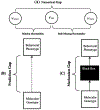Three legs of the missing heritability problem
- PMID: 35533541
- PMCID: PMC9172633
- DOI: 10.1016/j.shpsa.2022.04.004
Three legs of the missing heritability problem
Abstract
The so-called 'missing heritability problem' is often characterized by behavior geneticists as a numerical discrepancy between alternative kinds of heritability. For example, while 'traditional heritability' derived from twin and family studies indicates that approximately ∼50% of variation in intelligence is attributable to genetics, 'SNP heritability' derived from genome-wide association studies indicates that only ∼10% of variation in intelligence is attributable to genetics. This 40% gap in variance accounted for by alternative kinds of heritability is frequently referred to as what's "missing." Philosophers have picked up on this reading, suggesting that "dissolving" the missing heritability problem is merely a matter of closing the numerical gap between traditional and molecular kinds of heritability. We argue that this framing of the problem undervalues the severity of the many challenges to scientific understanding of the "heritability" of human behavior. On our view, resolving the numerical discrepancies between alternative kinds of heritability will do little to advance scientific explanation and understanding of behavior genetics. Thus, we propose a new conceptual framework of the missing heritability problem that comprises three independent methodological and explanatory challenges: the numerical gap, the prediction gap, and the mechanism gap.
Keywords: Behavior genetics; Explanation; Genomics; Heritability; Mechanism; Prediction.
Copyright © 2022 Elsevier Ltd. All rights reserved.
Figures

Similar articles
-
Childhood behaviour problems show the greatest gap between DNA-based and twin heritability.Transl Psychiatry. 2017 Dec 12;7(12):1284. doi: 10.1038/s41398-017-0046-x. Transl Psychiatry. 2017. PMID: 29234009 Free PMC article.
-
Heritability jointly explained by host genotype and microbiome: will improve traits prediction?Brief Bioinform. 2021 May 20;22(3):bbaa175. doi: 10.1093/bib/bbaa175. Brief Bioinform. 2021. PMID: 32810866
-
Missing heritability and strategies for finding the underlying causes of complex disease.Nat Rev Genet. 2010 Jun;11(6):446-50. doi: 10.1038/nrg2809. Nat Rev Genet. 2010. PMID: 20479774 Free PMC article. Review.
-
Dominant Genetic Variation and Missing Heritability for Human Complex Traits: Insights from Twin versus Genome-wide Common SNP Models.Am J Hum Genet. 2015 Nov 5;97(5):708-14. doi: 10.1016/j.ajhg.2015.10.004. Am J Hum Genet. 2015. PMID: 26544805 Free PMC article.
-
Twins and the mystery of missing heritability: the contribution of gene-environment interactions.J Intern Med. 2012 Nov;272(5):440-8. doi: 10.1111/j.1365-2796.2012.02587.x. Epub 2012 Oct 11. J Intern Med. 2012. PMID: 22934540 Free PMC article. Review.
Cited by
-
Correlations of the CNR1 Gene with Personality Traits in Women with Alcohol Use Disorder.Int J Mol Sci. 2024 May 9;25(10):5174. doi: 10.3390/ijms25105174. Int J Mol Sci. 2024. PMID: 38791212 Free PMC article.
-
BIGFAM - variance components analysis from relatives without genotype.Nat Commun. 2025 Jul 1;16(1):5476. doi: 10.1038/s41467-025-60502-0. Nat Commun. 2025. PMID: 40593523 Free PMC article.
-
Multi-ancestry Genome-Wide Association Meta-Analysis Identifies Novel Loci in Atopic Dermatitis.medRxiv [Preprint]. 2024 Jun 19:2024.06.17.24308897. doi: 10.1101/2024.06.17.24308897. medRxiv. 2024. PMID: 38946956 Free PMC article. Preprint.
-
Shared genetic loci between Alzheimer's disease and multiple sclerosis: Crossroads between neurodegeneration and immune system.Neurobiol Dis. 2023 Jul;183:106174. doi: 10.1016/j.nbd.2023.106174. Epub 2023 Jun 5. Neurobiol Dis. 2023. PMID: 37286172 Free PMC article.
-
Genomics and psychiatric nosology: avoiding hype, maintaining hope.World Psychiatry. 2025 Jun;24(2):190-191. doi: 10.1002/wps.21301. World Psychiatry. 2025. PMID: 40371764 Free PMC article. No abstract available.
References
-
- Borkenau P, Riemann R, Angleitner A, & Spinath FM (2002). Similarity of childhood experiences and personality resemblance in monozygotic and dizygotic twins: A test of the equal environments assumption. Personality and Individual Differences, 33(2), 261–269. 10.1016/S0191-8869(01)00150-7 - DOI
-
- Bourrat P, & Lu Q (2017). Dissolving the Missing Heritability Problem. Philosophy of Science, 84(5), 1055–1067. 10.1086/694007 - DOI
MeSH terms
Grants and funding
LinkOut - more resources
Full Text Sources
Miscellaneous

